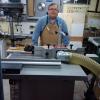So I spent a fair bit of time today working on my shopbuilt mobile base for Uncle Max. Unfortunately, I suffered a problem, or more accurately a near catastrophic failure.
This is the J/P on the mobile base is this first pic. The machine sits on its own feet when on the ground, lever action lifts the base, and then the machine, and away we go. At least, that's the theory.
Big Max Mobile Base.jpg
While testing the lift/lever action, gremlins attacked, as shown in the second pic.
Big MaxMobile Base Fail.jpg
The entire mobile base is 1.5" thick Douglas Fir, casters are 4", bolted through the DF. The levers are also bolted through the DF. As the pic shows, the caster "plank" failed along the grain line, which coincided with some of the bolt holes.
So, I'm coming here to plumb the collected wisdom of the Creek. I've two problems. The first is the failed plank. I see these possible solutions:
- Replace with a new plank, i.e. go with the assumption that the plank was a weak one.
- Replace with a new plank and make sure that the bolt holes do not align across the same grain
- Glue up a new plank with grain running "fore - aft" rather than across as the existing failed plank.
- Glue up a double thickness of plywood for a plank.
- Something else??? Explain.
My second problem is how to lock the caster planks down. Any suggestions?




 Reply With Quote
Reply With Quote




 .
.




